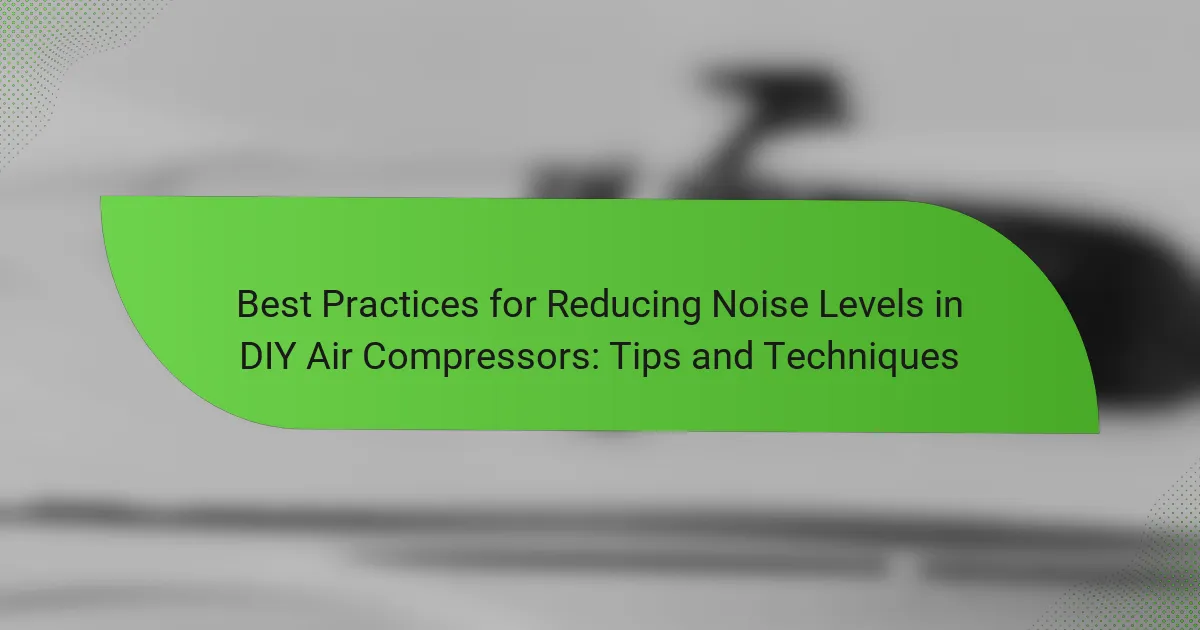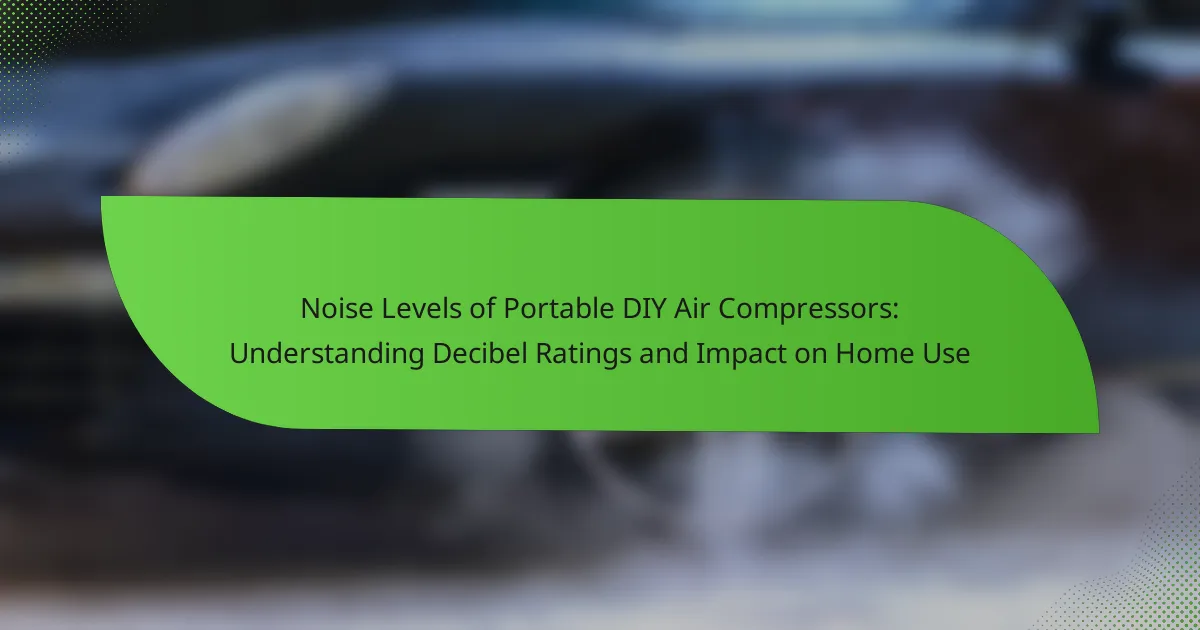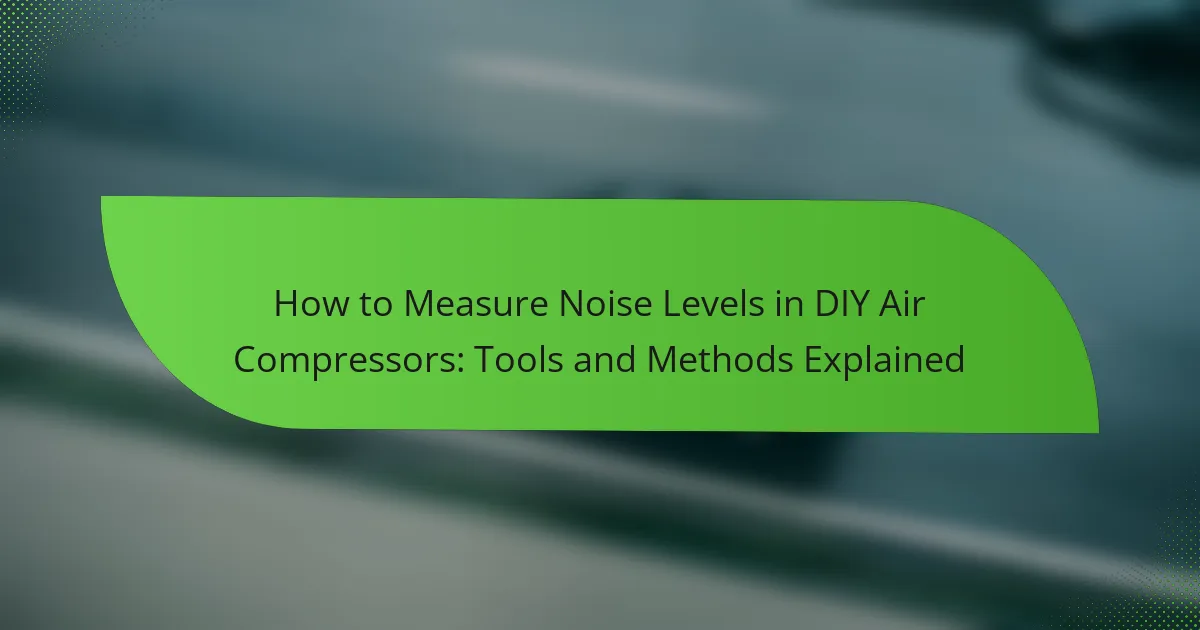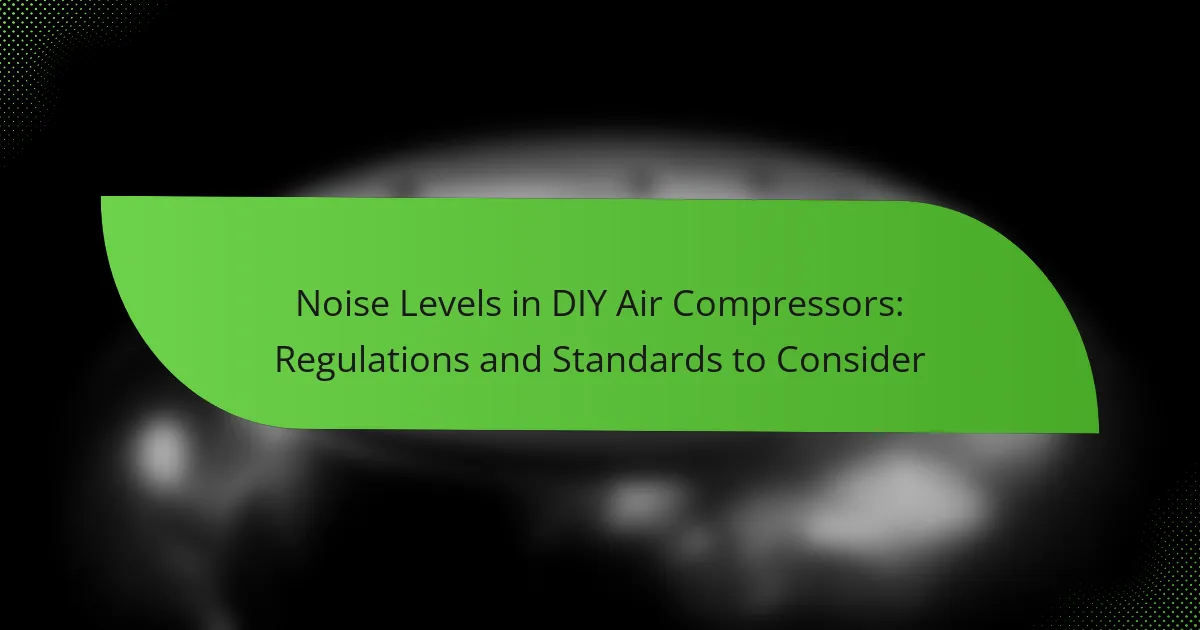Noise levels in DIY air compressors refer to the sound intensity produced during operation, typically ranging from 60 dB to 90 dB. High noise levels can indicate mechanical strain, leading to discomfort, potential hearing damage, and reduced efficiency. Vibration, caused by the motor and moving parts, can further contribute to noise and affect compressor performance. Strategies to mitigate noise and vibration include using vibration isolation pads, enclosing compressors in soundproof boxes, and regular maintenance. Selecting compressors with lower decibel ratings can also enhance performance while minimizing disruptive sound and vibration.
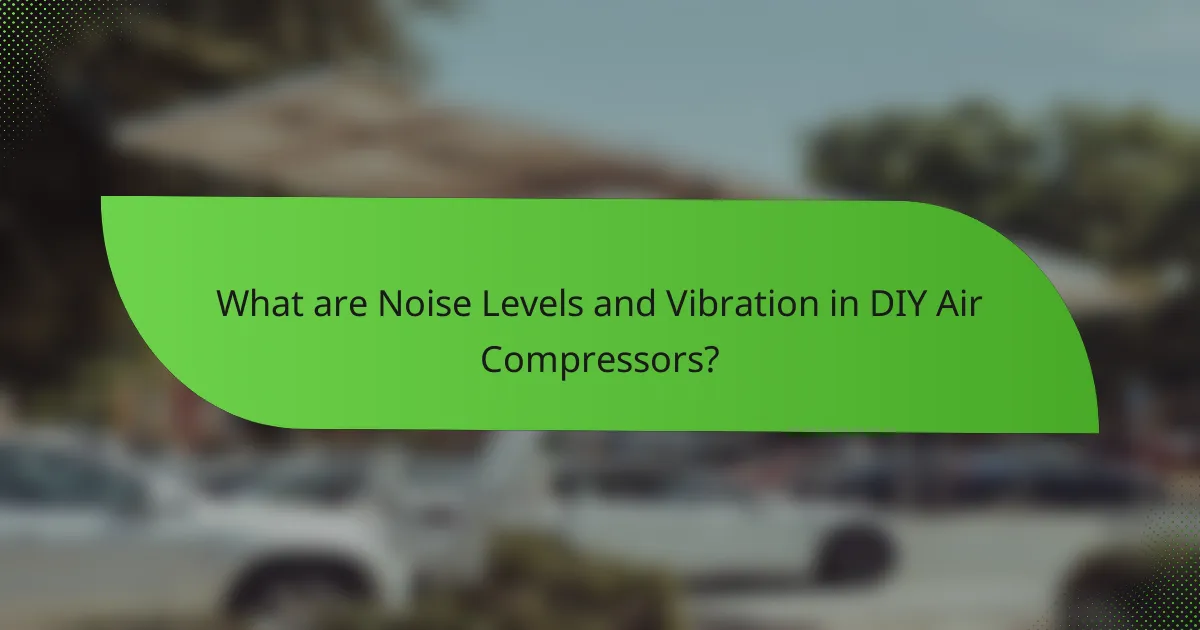
What are Noise Levels and Vibration in DIY Air Compressors?
Noise levels in DIY air compressors refer to the sound intensity produced during operation. Typically, noise levels range from 60 dB to 90 dB, depending on the compressor type and design. Higher noise levels can lead to discomfort and potential hearing damage over prolonged exposure. Vibration in DIY air compressors is the physical movement or shaking caused by the compressor’s motor and moving parts. Excessive vibration can lead to mechanical wear and affect the compressor’s performance. It can also contribute to noise levels, creating a feedback loop of sound and vibration. Both noise and vibration are important factors to consider for user safety and equipment longevity.
How do noise levels impact the performance of DIY air compressors?
Noise levels significantly impact the performance of DIY air compressors. High noise levels can indicate inefficiencies within the compressor. These inefficiencies often stem from mechanical issues or poor maintenance. Excessive noise may also lead to vibrations that affect the compressor’s stability.
Vibrations can cause misalignment of components, reducing operational efficiency. Studies show that compressors operating at optimal noise levels function more effectively. For instance, a quieter compressor typically indicates smoother operation and less wear on parts.
In contrast, noisy compressors may consume more energy to maintain pressure. This can lead to increased operational costs and reduced lifespan. Overall, managing noise levels is crucial for maintaining optimal performance in DIY air compressors.
What are the common sources of noise in air compressors?
Common sources of noise in air compressors include the motor, the compressor pump, and air discharge. The motor generates noise during operation, often due to vibrations. The compressor pump creates sound from the compression process, which can be amplified by the housing. Air discharge noise occurs when compressed air exits the tank or hoses. Additionally, vibrations from the compressor can transfer to the ground or surrounding structures, increasing perceived noise levels. According to the American National Standards Institute, noise levels can reach up to 90 dB in some models, making these sources significant contributors to overall sound output.
How can excessive noise levels affect user experience?
Excessive noise levels can significantly degrade user experience. High noise levels can lead to distraction and decreased focus on tasks. Research indicates that noise can increase stress levels, negatively impacting mental well-being. Studies show that environments with noise levels above 70 decibels can cause discomfort and irritability. Users may experience fatigue due to prolonged exposure to loud sounds. Additionally, excessive noise can hinder communication, making it difficult to interact effectively. Overall, high noise levels can create a frustrating and unproductive atmosphere for users.
Why is vibration an important factor in air compressor operation?
Vibration is an important factor in air compressor operation because it affects performance and longevity. Excessive vibration can lead to mechanical wear and tear on components. This can result in misalignment and increased maintenance costs. Moreover, vibration can indicate underlying issues, such as imbalance or loose parts. Studies show that vibration levels above certain thresholds can lead to premature failure. Monitoring vibration helps ensure optimal operation and efficiency. Regular checks can prevent costly repairs and extend the lifespan of the compressor.
What causes vibration in DIY air compressors?
Vibration in DIY air compressors is primarily caused by imbalances in the rotating components. These imbalances can occur due to uneven wear or improper assembly of parts. Additionally, loose or worn-out mounting hardware can amplify vibrations. Misalignment of the motor and pump can also lead to excessive movement. Another factor is the operational speed; higher speeds can increase vibration levels. Furthermore, inadequate damping materials may fail to absorb vibrations effectively. Each of these factors contributes to the overall vibration experienced during compressor operation.
How does vibration influence the longevity of air compressor components?
Vibration negatively influences the longevity of air compressor components. Excessive vibration can lead to mechanical wear and tear. This wear occurs due to the constant movement and stress on the components. Over time, this can result in misalignments and failures. A study by the American Society of Mechanical Engineers found that vibration increases the risk of component fatigue. Components such as bearings and seals are particularly susceptible to damage from vibration. Regular maintenance can mitigate these effects. Monitoring vibration levels helps in identifying potential issues early.
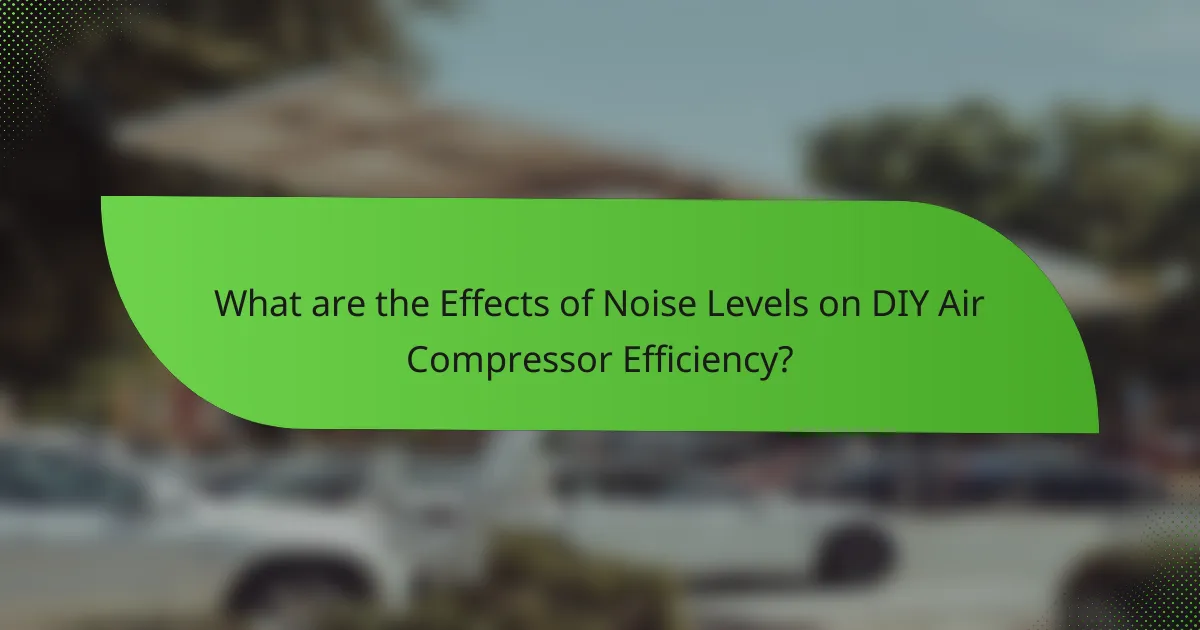
What are the Effects of Noise Levels on DIY Air Compressor Efficiency?
High noise levels can negatively impact DIY air compressor efficiency. Increased noise often indicates mechanical strain or issues within the compressor. This strain can lead to higher energy consumption during operation. Research shows that compressors operating at lower noise levels tend to have improved performance metrics. For instance, a study by the American Society of Mechanical Engineers found that noise reduction correlates with enhanced efficiency. Additionally, excessive noise can signal wear and tear on components, further reducing efficiency over time. Therefore, maintaining lower noise levels is crucial for optimal DIY air compressor performance.
How do noise levels correlate with air compressor efficiency?
Noise levels in air compressors often correlate inversely with efficiency. Higher noise levels can indicate greater energy loss during operation. This loss typically arises from mechanical vibrations and turbulence within the compressor. Research shows that quieter compressors tend to operate more efficiently. For instance, a study by the American Society of Mechanical Engineers found that noise reduction technologies improved energy efficiency by up to 15%. Thus, lower noise levels generally suggest better air compressor performance and efficiency.
What are the measurable effects of noise on performance metrics?
Noise negatively impacts performance metrics in various environments. High noise levels can lead to decreased focus and increased stress among workers. Studies show that a noise level of 85 dB can reduce productivity by 20-30%. Additionally, noise can cause communication difficulties, further impairing team performance. Research indicates that prolonged exposure to noise can result in fatigue and errors in tasks. The effects are measurable through metrics such as task completion time and error rates. For example, a study by the World Health Organization demonstrated that noise exposure correlates with increased mistakes in industrial settings.
How can noise reduction techniques improve efficiency?
Noise reduction techniques can improve efficiency by minimizing distractions and enhancing focus. Lower noise levels lead to better concentration for operators. This increased focus can result in higher productivity and more accurate work. Research indicates that reducing noise can decrease stress levels, which positively impacts job performance. For instance, a study published in the Journal of Environmental Psychology found that quieter environments boost cognitive function. Additionally, noise reduction can extend the lifespan of equipment by reducing wear and tear caused by vibrations. Overall, implementing noise reduction strategies fosters a more effective and efficient working environment.
What are the health implications of high noise levels?
High noise levels can lead to various health implications. Prolonged exposure to loud noise can cause hearing loss. According to the World Health Organization, noise levels above 85 decibels can damage hearing over time. High noise levels also contribute to increased stress and anxiety. Chronic stress from noise exposure can lead to cardiovascular issues. Research indicates that noise pollution is linked to high blood pressure and heart disease. Additionally, sleep disturbances are common in noisy environments. Poor sleep can further exacerbate health problems. Overall, high noise levels negatively impact both physical and mental health.
How does prolonged exposure to noise affect users?
Prolonged exposure to noise negatively affects users’ health and well-being. It can lead to hearing loss, sleep disturbances, and increased stress levels. Research indicates that continuous noise exposure can elevate blood pressure and heart rate. Additionally, it may impair cognitive functions and reduce productivity in work environments. A study published in the Journal of Environmental Health found that chronic noise exposure is linked to a higher incidence of anxiety and depression among individuals. The World Health Organization states that noise pollution is a significant environmental risk to public health.
What safety regulations should be considered regarding noise levels?
Safety regulations regarding noise levels include the Occupational Safety and Health Administration (OSHA) standards. OSHA sets permissible noise exposure limits to protect workers’ hearing. The limit is 90 decibels for an 8-hour workday. Employers must implement a hearing conservation program when noise exceeds this level. Additionally, the Environmental Protection Agency (EPA) provides guidelines on noise pollution. Local ordinances may also impose stricter regulations on noise levels. Compliance with these regulations helps ensure workplace safety and community well-being.
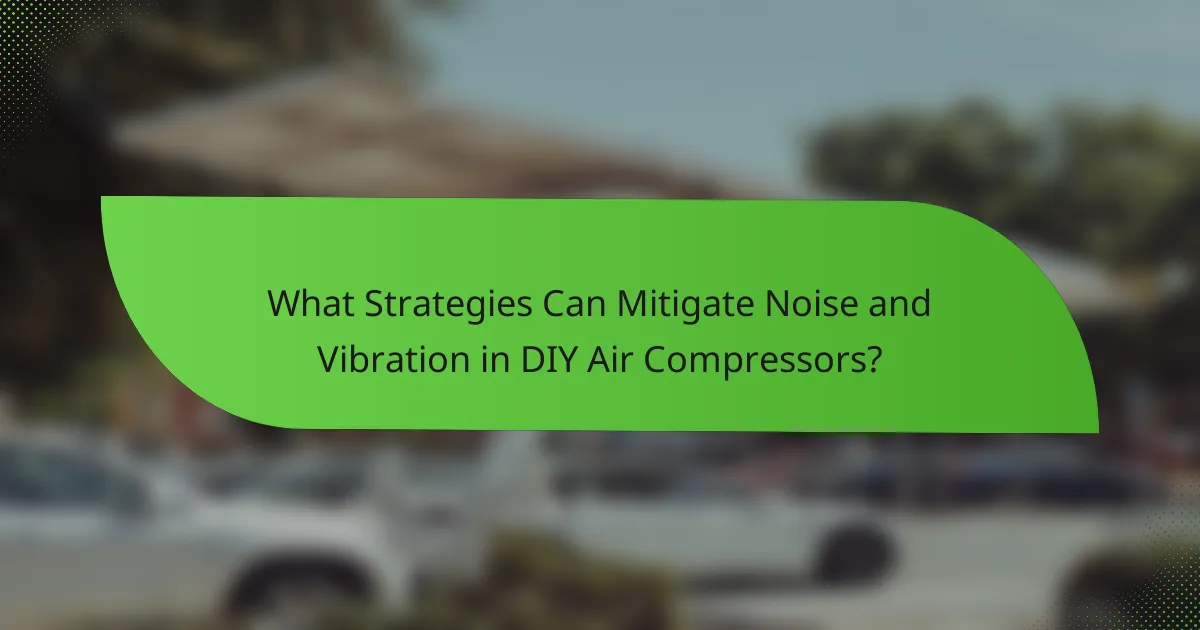
What Strategies Can Mitigate Noise and Vibration in DIY Air Compressors?
To mitigate noise and vibration in DIY air compressors, several strategies can be implemented. First, using vibration isolation pads can significantly reduce the transmission of vibrations to the surface beneath the compressor. These pads are designed to absorb vibrations and prevent them from spreading. Second, enclosing the compressor in a soundproof box can help contain noise. This box should have sound-absorbing materials to further decrease sound levels. Third, maintaining the compressor regularly can minimize noise and vibration caused by wear and tear. Loose components can create additional noise and vibration, so ensuring everything is tightened is crucial. Lastly, selecting a compressor with a lower decibel rating can inherently reduce noise levels. Compressors designed with quieter technology often produce less vibration as well. These strategies collectively enhance the performance of DIY air compressors while minimizing disruptive noise and vibration.
How can users reduce noise levels in their DIY air compressors?
Users can reduce noise levels in their DIY air compressors by implementing soundproofing measures. Installing acoustic insulation around the compressor can significantly dampen sound. Using vibration pads or mounts will minimize noise caused by vibrations. Additionally, enclosing the compressor in a soundproof box can further contain noise. Maintaining the compressor regularly can prevent excessive noise from mechanical issues. Selecting quieter compressor models or adding mufflers can also help. Research shows that soundproofing can reduce noise levels by up to 50%.
What materials and techniques are effective for soundproofing?
Effective materials for soundproofing include mass-loaded vinyl, acoustic panels, and soundproof drywall. Mass-loaded vinyl adds density to walls, reducing sound transmission. Acoustic panels absorb sound waves, minimizing echo and reverberation. Soundproof drywall incorporates sound-dampening materials, enhancing wall performance against noise. Techniques such as sealing gaps with acoustic caulk and using resilient channels also improve sound isolation. Installing double-glazed windows decreases sound infiltration from outside. These methods collectively reduce noise levels effectively, enhancing the performance of DIY air compressors.
How can compressor placement impact noise reduction?
Compressor placement significantly impacts noise reduction. Placing the compressor in a sound-insulated area minimizes noise transmission. Proximity to walls or hard surfaces can amplify sound reflections. Elevated positions can aid in reducing noise by utilizing gravity to dampen vibrations. Additionally, positioning the compressor away from living spaces decreases perceived noise levels. According to a study by the Acoustical Society of America, strategic placement can reduce noise levels by up to 10 dB. This reduction can enhance user comfort and improve overall performance.
What are the best practices for minimizing vibration?
To minimize vibration, use vibration-damping materials in construction. These materials absorb and reduce the energy from vibrations. Install anti-vibration mounts or pads to isolate equipment from surfaces. This can significantly reduce the transmission of vibrations. Regularly maintain and balance rotating equipment to prevent excessive vibration. Well-maintained machines operate more smoothly. Position equipment on a solid, level foundation to minimize movement. Ensure that all fasteners are tight to prevent loosening over time. Following these practices can lead to improved performance and reduced wear on DIY air compressors.
How can proper maintenance reduce vibration issues?
Proper maintenance can significantly reduce vibration issues in DIY air compressors. Regularly checking and tightening loose components minimizes imbalances that cause vibrations. Lubricating moving parts decreases friction, leading to smoother operation. Inspecting and replacing worn-out belts ensures they run evenly, preventing vibrations. Cleaning filters and cooling fins maintains optimal airflow, which reduces overheating and associated vibrations. Regularly balancing the compressor helps maintain stability during operation. According to a study by the National Institute for Occupational Safety and Health, proper maintenance can reduce equipment vibrations by up to 30%. This reduction enhances performance and prolongs the lifespan of the compressor.
What role does the foundation of the air compressor play in vibration control?
The foundation of the air compressor significantly influences vibration control. A solid and stable foundation helps to absorb and dissipate vibrations generated during operation. This stability minimizes the transmission of vibrations to surrounding structures. Proper mounting reduces the risk of equipment damage and extends the lifespan of the compressor. Studies indicate that inadequate foundations can lead to increased noise levels and operational inefficiencies. For example, a study from the Journal of Vibration and Acoustics highlights that vibration isolation systems can reduce noise by up to 50%. Thus, a well-designed foundation is crucial for effective vibration management in air compressors.
What troubleshooting tips can help improve performance related to noise and vibration?
To improve performance related to noise and vibration in DIY air compressors, check for loose components. Tightening bolts and screws can significantly reduce noise. Inspect the mounting surface for stability. An unstable surface can amplify vibrations. Use rubber pads or vibration isolators to absorb shock. These materials help dampen vibrations effectively. Regularly maintain the compressor by lubricating moving parts. Proper lubrication minimizes friction and noise. Ensure that air filters are clean to promote efficient operation. Clogged filters can increase noise and reduce performance. Lastly, consider enclosing the compressor in a sound-dampening cabinet. This can further help in reducing noise levels.
The main entity of this article is DIY air compressors, specifically focusing on noise levels and vibration. The article explores how noise levels, ranging from 60 dB to 90 dB, impact user experience, performance efficiency, and health implications. It details the sources of noise and vibration, their effects on compressor longevity, and strategies for mitigation, including soundproofing techniques and proper maintenance practices. Additionally, the article emphasizes the correlation between noise reduction and improved operational efficiency, outlining best practices for minimizing both noise and vibration in DIY air compressors.
